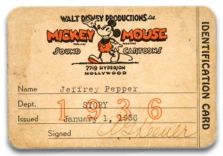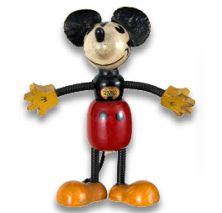
 In 1982, EPCOT Center opened, costing an astonishing $1,400,000,000. 1983 was the year of Horizons, of The Disney Channel, of Tokyo Disneyland, and of a huge executive shakeup which resulted in the ousting of Ron Miller and the installation of Michael Eisner and Frank Wells. Lake Buena Vista, as well as all significant development at Walt Disney World and Disneyland would be put on hold until the duo would get the movie side of the company knocked into shape.
In 1982, EPCOT Center opened, costing an astonishing $1,400,000,000. 1983 was the year of Horizons, of The Disney Channel, of Tokyo Disneyland, and of a huge executive shakeup which resulted in the ousting of Ron Miller and the installation of Michael Eisner and Frank Wells. Lake Buena Vista, as well as all significant development at Walt Disney World and Disneyland would be put on hold until the duo would get the movie side of the company knocked into shape. 1983 saw two more hotels join the Motor Plaza across from the Village – the Buena Vista Palace and the Orlando Hilton. And in 1985, the collection of Villas - which had never quite ever been unified under a single name - became the Walt Disney World Village Resort. By this time, the Lake Buena Vista Club had been renovated to become more family friendly. And in 1989, to coincide with the opening of Pleasure Island and the renaming of the Walt Disney World Village to the Disney Village Marketplace, the Villas’ name was again shortened to Disney’s Village Resort.
Club Lake Villas pool, early 1990's
 A 1995 construction project saw big changes and not so big changes at the Village Resort. Club Lake became Willow Lake – a not unfitting name change due to its’ willow dotted shoreline – and the Club Lake Villas and Conference Center were painted in low key earth tones and re-named the Bungalows (left). The Conference Center’s interior was converted into classrooms and became the North Studios. A rock climbing wall was constructed in the forest behind the Conference Center, near two new structures known as the Teaching Gardens.
A 1995 construction project saw big changes and not so big changes at the Village Resort. Club Lake became Willow Lake – a not unfitting name change due to its’ willow dotted shoreline – and the Club Lake Villas and Conference Center were painted in low key earth tones and re-named the Bungalows (left). The Conference Center’s interior was converted into classrooms and became the North Studios. A rock climbing wall was constructed in the forest behind the Conference Center, near two new structures known as the Teaching Gardens.The Treehouses remained relatively the same in name and appearance, getting a new coat of paint and new interiors. Gone were the rich wood tones, replaced with white painted interiors and uninspired décor. The shag carpets went away. The Vacation Villas were re-dubbed the Townhouses and got by with a new coat of exterior paint. The collection of four houses, rarely used, became Grand Vista Homes. The Fairway Villas were not so fortunate, retaining their name but now painted in garish “tropical” colors. A similar fate befell the Polynesian Village and Village Marketplace, once wonderlands of natural stone and wood, now caked with bright primaries. All of the original community pools were refurbished but untouched. Unlike Eisner developments like Dixie Landings or Caribbean Beach, there would be no central themed swimming pool.
 The bulk of the work went on in and around the Buena Vista Club, which finally expanded to become a central lobby and check in facility for the surrounding villas. The Club was built up on the land side, stretching north and east to nearly three times her original dimensions, then west again. The space of the original Lake Buena Vista Club became a dining room known as ‘Seasons’, retaining the original outside patio seating as ‘Seasons Terrace’. On the north side of the new facility, overlooking the ampitheater through tall, sun-splashed windows was a lounge called The Gathering Place, dressed in sophisticated whites and wood tones, high-beamed ceilings, and wispy silky hangings. A signature red tower rose to the West - a dramatic entrance lobby - which linked back to a new façade on the north side designed to mirror the signature chalet-roof of the original Club. A general goods store called Dabblers appeared off the lobby in the main building. This rambling structure also pushed east, widening and swelling to a huge warehouse of a health club and spa.
The bulk of the work went on in and around the Buena Vista Club, which finally expanded to become a central lobby and check in facility for the surrounding villas. The Club was built up on the land side, stretching north and east to nearly three times her original dimensions, then west again. The space of the original Lake Buena Vista Club became a dining room known as ‘Seasons’, retaining the original outside patio seating as ‘Seasons Terrace’. On the north side of the new facility, overlooking the ampitheater through tall, sun-splashed windows was a lounge called The Gathering Place, dressed in sophisticated whites and wood tones, high-beamed ceilings, and wispy silky hangings. A signature red tower rose to the West - a dramatic entrance lobby - which linked back to a new façade on the north side designed to mirror the signature chalet-roof of the original Club. A general goods store called Dabblers appeared off the lobby in the main building. This rambling structure also pushed east, widening and swelling to a huge warehouse of a health club and spa.It’s easy to fault Eisner for thinking small due to the legacy of the last ten years of his post at Disney – cheap direct to video sequels, under funded theme parks, bad decisions, and the wreckage of nearly every division in the company - rife with aborted brilliant projects and promising ideas fulfilled on the cheap. But his first ten years in office were as promising as his last ten were disappointing, and the Disney Institute is emblematic of this. It’s a concept that simply wouldn’t even be considered now, fifteen years later.
It’s important to realize about Eisner’s early efforts in the theme park division that prestige was as important to him as profit, sometimes beyond any economic reality, and it is his efforts to bring Disney into the world of contemporary adult recreation that we have to thank for Walt Disney World’s current fleet of modern, stylish restaurants and resorts. The Disney Institute was similarly a prestige product – aimed at somebody who wasn’t very interested, perhaps, in spending all of their time in the theme parks – a stance which is today unthinkable. “You won’t believe what you can do!”, promises a 1998 brochure: “It’s a whole new vacation experience where you can do things you you’ve always wanted to do. You can custom design your vacation, making it as active or relaxed, as you like. A Disney Institute vacation will allow you to combine intriguing and engaging programs with outstanding recreational opportunities. These activities and programs are designed to stretch your body and mind. You’ll have opportunities to see, hear, and do things you never thought possible.”
Rather than work against what was there in 1978, the Disney Institute project embraced the subdued, adult atmosphere of the Lake Buena Vista Villas by crafting a subdued, adult recreation resort, only building onto an existing structure to add the needed support facilities of a modern resort-hotel. Children under the age of seven couldn’t even enroll in any of the Disney Institute programs, and those younger than seventeen didn’t have too many options either. Families with young kids could take their business to one of the other Disney resorts. The program categories were:
Entertainment Arts: Radio, TV, Photography, Acting, Animation, etc
Design Arts: Painting, Decorating, Drawing, Sketching
Story Arts: Disney storytelling
Lifestyles: Self-help, Motivational seminars
Sports and Fitness: Golf, Tennis, Aerobics, Swimming, etc
Culinary Arts: Disney Chef demonstrations
Gardening and the Great Outdoors: Gardening, Landscaping, Conservation
Performing Arts and Film: visiting celebrity ‘instructors’
Youth Programs
But within just a few years, it was clear that the Disney Institute was not becoming very popular with Walt Disney World guests, despite Disney’s massive marketing campaign to keep the resort in the public eye. The Seasons Dining Room had closed, unable to compete with the Village’s offerings across the water – Pleasure Island had, in fact, expanded in 1998, creating the West Side, and the entire trifecta of Village, Pleasure Island and West Side was again rebranded – Downtown Disney. The reasons why the Institute was not doing well are easy to guess at. First is that not many guests at Walt Disney World, then or now, are too interested in taking time out of their vacations for an extracurricular class. Another may be saturation. While Walt Disney World has grown, the average length of the American vacation has not. Eisner’s construction mania may have finally done in his brainchild – when he and Frank Wells inherited Walt Disney World in 1984, it comprised two theme parks, a 100,000 square foot shopping complex, five Disney-owned hotels and six participant hotels. Today there are four theme parks, a 300,000+ square foot shopping complex, seventeen Disney-owned hotels, seven timeshare resorts, eleven participant hotels, and four miniature golf courses. And with only slightly over 450 rooms – the average Disney hotel is more like 850 – and a cast member to guest ratio of one to fifteen, the Institute was a costly failure.
In the meantime, the Disney Vacation Club had ballooned up. In 1996, more Vacation Club units opened at the new Boardwalk resort, and several hundred more were added every two years henceforth, so many that, in fact, the original 1991 development lost it’s status as the singular “Disney Vacation Club” and became “Old Key West”. Since Vacation Club memberships are flexible, require payment up front and yearly dues, and tend to sell pretty quickly, they are a relatively risk free way to build rooms in the Florida property. Even if you build a quality hotel, there’s no guarantee that anybody will come stay in it, and even if they do, it may take years to recoup costs. Vacation Club timeshares sell quickly and return dividends rapidly – as the fastest growing and most consistently profitable element of Walt Disney World by the end of the 1990’s, the writing was on the wall.
After the bottom fell out of the tourism industry in the United States in late 2001, Disney shut a number of resorts – including the Disney Institute. When it finally closed in 2002, the most cost effective measure was to convert the entire Lake Buena Vista development into Vacation Club properties, properties that continue to rake in profits every year – for 50 years. Disney chose to keep the newest developments – the Disney Institute “downtown” with its spa – and a bulldozer did what Eisner had not done back in 1995. Every original building was leveled.
Well, almost.
In the tourism slump which was fallout of the September 2001 terrorist attacks, Disney had quietly shuttered the Treehouses and was using them for housing for International College Program Cast Members. But 2004’s Hurricane Charley, which had unexpectedly hit Florida and caused nearly $13 billion dollars in damage, seriously impacted several original Treehouses and the entire complex was abandoned while construction continued on the site of the former Disney Institute.
Above: the Treehouse kitchen in 1976.
Below: the Treehouse kitchen in 2003, as Cast Member housing.
The Disney Institute concept’s lineage in the Chautauqua Institution resulted in an upper-crust New England atmosphere which had to be honored if the Institute buildings were to be kept, which in turn resulted in a new theme, another one borrowed from upstate New York and the old resort town of Saratoga. Because the original pools and recreation centers of the Lake Buena Vista Villas had been destroyed with the rest of the 1970’s structures, the Disney Institute’s amphitheater became a family-oriented swimming pool themed to Saratoga’s famed hot springs. Everything else remaining received a minor horse-themed overlay: the lobby became known as the “Carriage House”, the Seasons dining room re-opened as the “Turf Club” with whimsical jockey jackets on the walls, and so on. The new four-story, cookiecutter design hotel units matched the Disney Institute structures remarkably well except in one area – quaint charm. The first units of the Saratoga Springs Resort & Spa were ready in May of 2004.
Finally in 2007, the original Treehouses began to come down, replaced with modern versions which, unlike the 1974 Treehouses, were totally elevated, which increased the net drainage space under each structure and allowed Disney to legally work on the protected wetland. The new versions, large, sleek, and modern, opened in 2009 as deluxe accommodations. A legacy that had begun even before Walt Disney World had opened had finally ended.
The Club Lake Villas/Bungalows shortly before demolition.
The bridge was retained for Saratoga Springs, but rebuilt.
--
Next week: a Postscript and Why We Should Care





























6 comments:
Hard to read this installment without feeling a bit sad. Nothing against DVC, I own at BWV & BLT, but to see that nearly everything was bulldozed for SSR seems so wasteful. I'm not always a fan of 'Out with the old in with the new' sometimes there is room for both. I loved the Lake Buena Vista area as a child & now as an adult, I would LOVE a more 'adult oriented' place to escape to during my WDW stay. Nothing against children either - I've got 3, anyway, another great post!
Good to see the LBV legacy documented. Several things were new to me in this series. Great work.
What a wonderful series! It's sad what has happened to LBV, but it's great to read and relive the history of the area. I have learned a lot from reading these posts.
I am looking forward to the final part of the series next week. Great job!
I think part of the issue with the new Saratoga buildings is that it appears all of the trees were torn out as well from the old villas land (which would make sense since the footprints of the old versus new buildings are totally different). I think Saratoga will "feel" very different in even ten years time when the new trees have grown some.
I wonder if the Disney Institute would have succeeded if done at a separate location from the parks. It seems like a really neat idea!
So ironic that I am planning to stay at Saratoga this year and didn't know that was where the Villas of my childhood were located. I read all this trying to find out. I look forward to trying to recognize anything familiar, but it appears it will all be gone.
Post a Comment